Do you take the time to read through the list of ingredients in your skincare items? We highly suggest you do. You may have noticed two of the most common ingredients – salicylic acid and niacinamide.
One is a beta-hydroxy acid, and the other is a form of vitamin B3. These two are especially useful for people with oily skin, large pores, and adult acne. But even if you don’t have those issues, they still provide multiple advantages for all skin types.
However, it can be tricky to figure out how to use these ingredients together and in what order. We can help you out with that.
This post will tell you about the advantages of salicylic acid and niacinamide for your skin and the proper way to incorporate them into your routine.
What is salicylic acid?
Salicylic acid is a well-known, naturally-derived chemical exfoliant and BHA (beta-hydroxy acid). This oil-soluble acid is derived from willow bark and is known for its potent ability to combat acne.
When dead skin cells accumulate excessively beneath the skin’s surface, they form white and blackheads. Salicylic acid breaks down the bond between these dead cells and clears out the clogged pores, enabling the skin to produce its own moisturizer, sebum.
Additionally, it prevents pores from getting blocked in the first place by exfoliating away dead, dry skin. Moreover, salicylic acid is known for its anti-bacterial and anti-inflammatory effects, which can aid in treating pustules and papules.

What are the benefits of using salicylic acid?
Salicylic acid is a well-recognized chemical exfoliator and is a member of the beta-hydroxy acid (BHA) family. Let’s take a look at the advantages that salicylic acid and other BHAs can bring to your skin:
- Penetrates deep into the skin with ease
- Softens and dissolves keratin
- Keeps the pores clean and free of oil and dead skin cells
- Dissolves some of the ‘glue’ that holds skin cells together
- Gently exfoliates the surface of the skin
- Includes mild anti-inflammatory properties
- Has antibacterial properties
- Fades post-acne marks and pigmentation
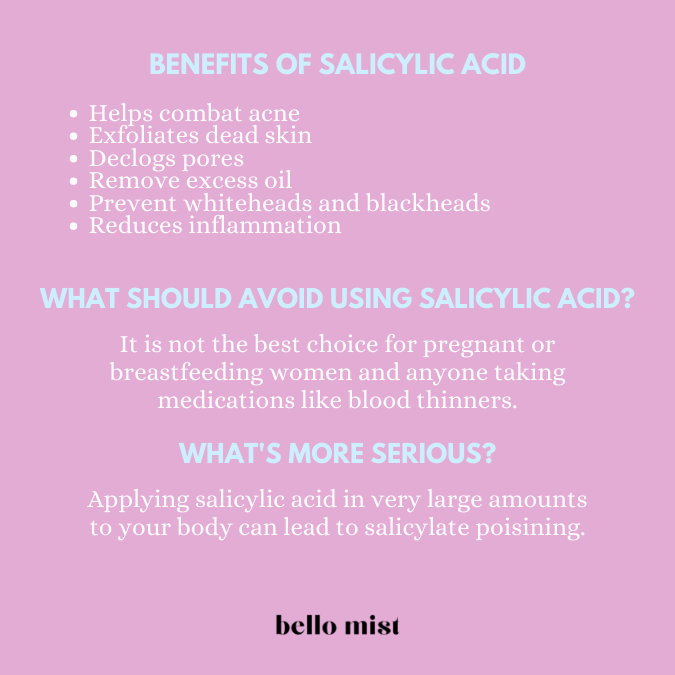
You can also try the milder alternatives of salicylic acids, such as betaine salicylate and willow bark extract, to achieve the same benefits.
Shop Salicylic Acid Cream
What is niacinamide?
Niacinamide is an incredibly versatile vitamin found in various foods, from yeast to meat, fish, eggs, green veggies, beans, and cereal grains.

As a dietary supplement and an active ingredient in skincare products, it is particularly effective at reducing the redness associated with blemishes when used in concentrations of two percent or more.
In addition, this gentle antioxidant helps to lower inflammation, brighten the skin, and encourage healthy collagen production – all while being suitable even for those with sensitive or rosacea-prone skin types.
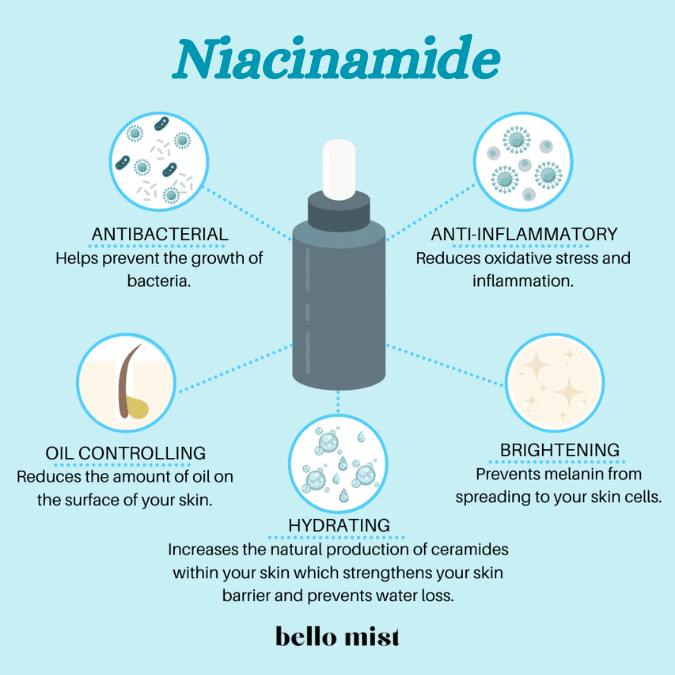
What are the benefits of using niacinamide?
Niacinamide is vitamin B3, a water-soluble nutrient for restoring cellular vitality and facilitating cell activity. Here are some of the advantages that this vitamin can bring to your skin:
- Controls excess oil and reduces acne
- Reduces pore size and count, likely by reducing surface sebum
- It improves uneven skin tone and softens fine lines and wrinkles
- Thickens the skin barrier and improves levels of ceramides and free fatty acids
- Reduces moisture loss and dehydration
- Reduces redness and sallowness
- Helps skin repair signs of past damage
- Boosts the hydrating properties of moisturizers.
Niacinamide is a beneficial ingredient. It can mix well with almost all ingredients in your skincare routine.
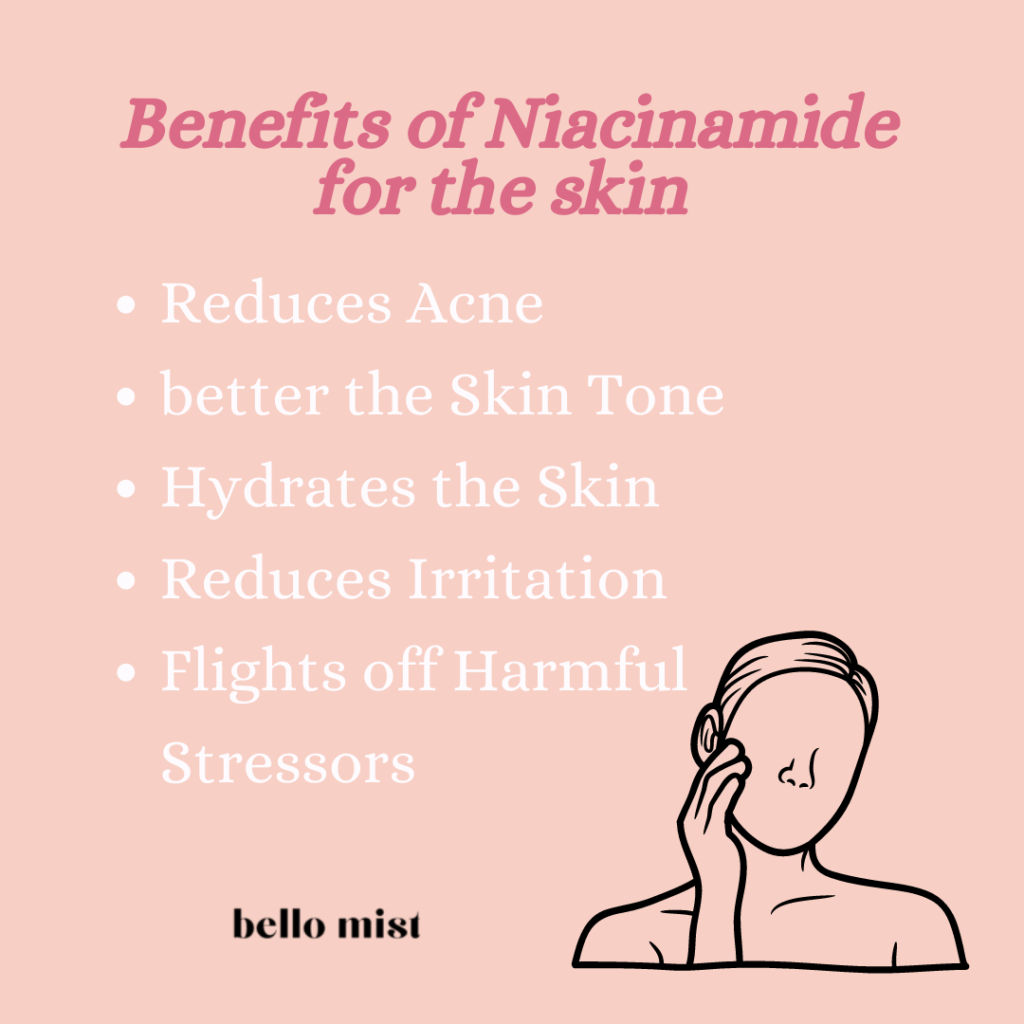
Can you use salicylic acid and niacinamide together?
The simple answer is yes. These two ingredients are a great pair. Salicylic acid can penetrate deep into the layers of your skin; however, it can be drying and irritating. Niacinamide, on the other hand, helps to soothe inflammation and support your skin’s natural hydration.
Suppose you are only using niacinamide. In that case, you won’t get the deep cleaning that salicylic acid can provide – niacinamide can assist with mild to moderate acne, but it won’t be able to remove dead skin cells or dislodge clogged sebum.
Adding salicylic acid to your skincare routine will do more to clear out existing breakouts and prevent future acne.
You may have noticed that salicylic acid and niacinamide have many similarities in their effects; they both help reduce oil, even out the skin’s texture, diminish the size of pores, and lighten up areas of discoloration.
However, they act differently, so combining the two offers the most significant potential for success.
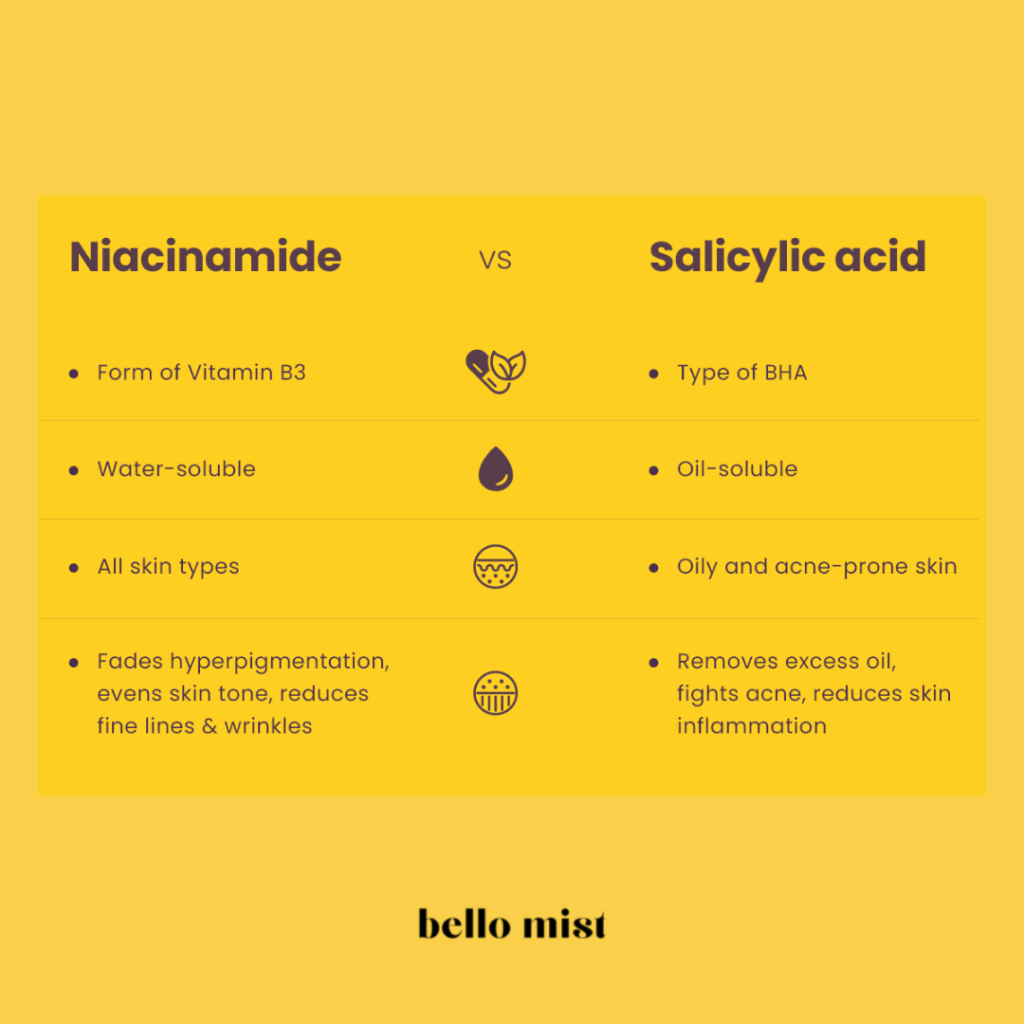
Potential side effects of mixing salicylic acid and niacinamide
It’s completely safe to use salicylic acid and niacinamide together; even better, we recommend it. These two components make up one of the most effective topical remedies for people with acne.
However, combining salicylic acid and niacinamide or using them simultaneously can trigger some side effects.
Let’s explain the potential side effects of salicylic acid and niacinamide:
1. Decreased Absorption of Salicylic Acid

The potency of salicylic acid relies on its acidic pH, usually between 3.0 and 4.0, to penetrate the skin and do its job.
A study indicated that the higher the pH, the lower the absorption rate in the skin. On the other hand, niacinamide is usually formulated with a neutral pH of 6.0.
If these two substances are combined, the niacinamide will increase the pH of the acid, making it less acidic and reducing the amount of salicylic acid that can be absorbed into the skin, thereby reducing its effectiveness.
2. The “Niacin Flush.”

Combining salicylic acid and niacinamide can create a redness and flushing effect on the skin since the acid can lower the pH of the niacinamide below its preferred range.
Niacinamide is best used at a pH of 6.0, and acidic conditions can trigger its transformation into niacin.
If you are familiar with taking oral niacin supplements, you may know of the well-known “niacin flush,” when your skin turns red, hot, and flushed. If you mix glycolic acid and niacinamide, the same can happen to your face.
This is why some people think they can’t use niacinamide, even though it’s one of the gentlest and safest ingredients in skincare – if it’s paired with an acid, it can seem like it’s irritating when it’s just the niacin flush.
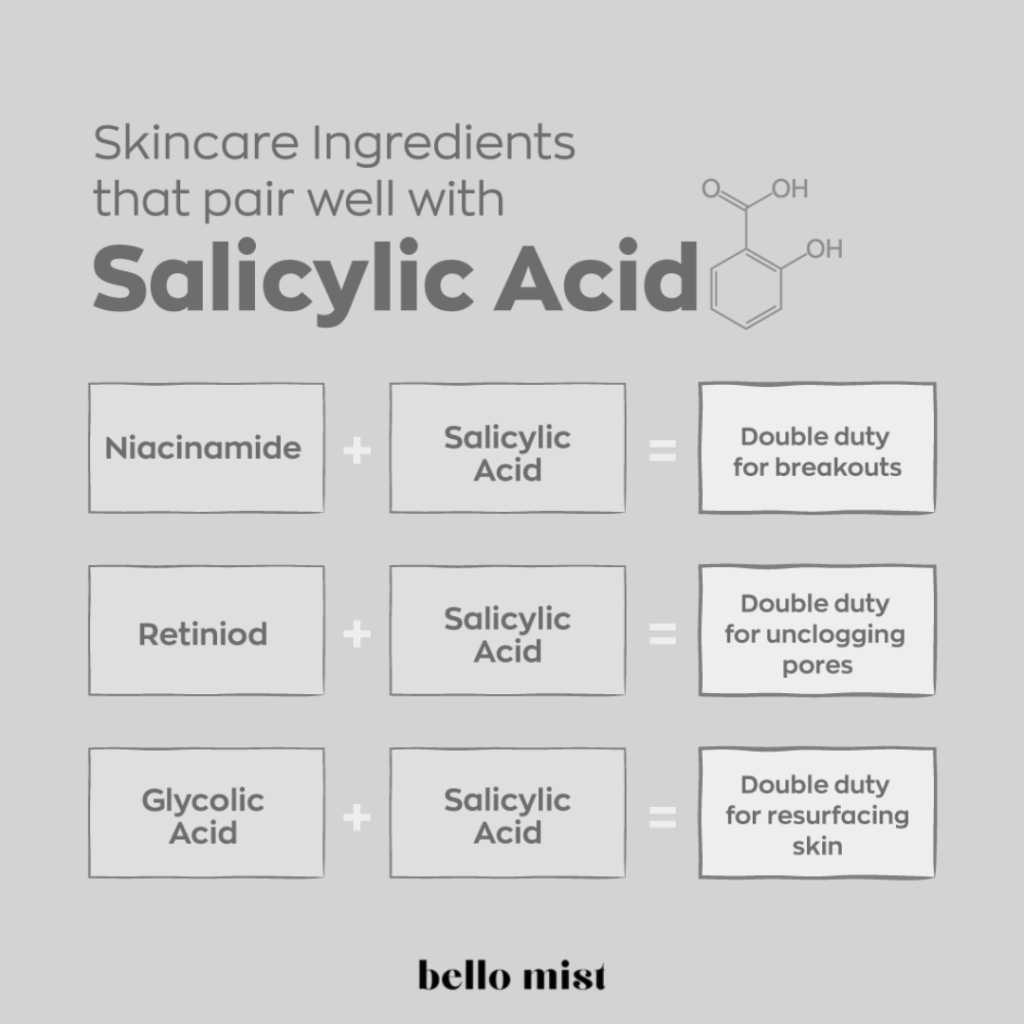
How to use salicylic acid and niacinamide in your skincare routine?
Fortunately, you can use salicylic acid and niacinamide in the same routine. Here are your most suitable options:

1. Apply Them in a Single Product
If you don’t want to combine two different products, you can opt for a pre-made formula containing salicylic acid and niacinamide. These formulas are created with great accuracy and are designed to work at specific pH levels.
However, the concentration of the active ingredients might be lower, and the pH level might not be as acidic as you would want it to be. Ultimately, it depends on whether you are willing to sacrifice potency for a convenient one-product solution.
2. Apply Them at Different Times of Day
To get the best results from two different products, try using them at separate times of the day. You can safely incorporate both ingredients into your morning or evening routine, depending on your preference.
Niacinamide serums work well in the morning, having the same neutral pH level as moisturizers and sunscreens. So, you can layer your hydration and sun protection without any worries.
On the other hand, salicylic acid must be kept separate from higher-pH products by a 30-minute gap to work at its ideal acidity. This waiting period is best done at night when you have more time to spare.
Apply the salicylic acid after cleansing and wait half an hour before applying any hydrating serums or night creams.
3. Apply Them 30 Minutes Apart
If you’re planning on using salicylic acid and niacinamide together in a single routine, it’s essential to give your skin a break between the two products.
Because acids should be applied first, you’ll want to start with the salicylic acid and give it 30 minutes to absorb and return your skin’s pH level to a standard, higher level (around 5.5). After the waiting period, you can apply niacinamide, any other hydration, and sunscreen.
Depending on how tolerant your skin is to the acid, you can use these ingredients up to twice daily.
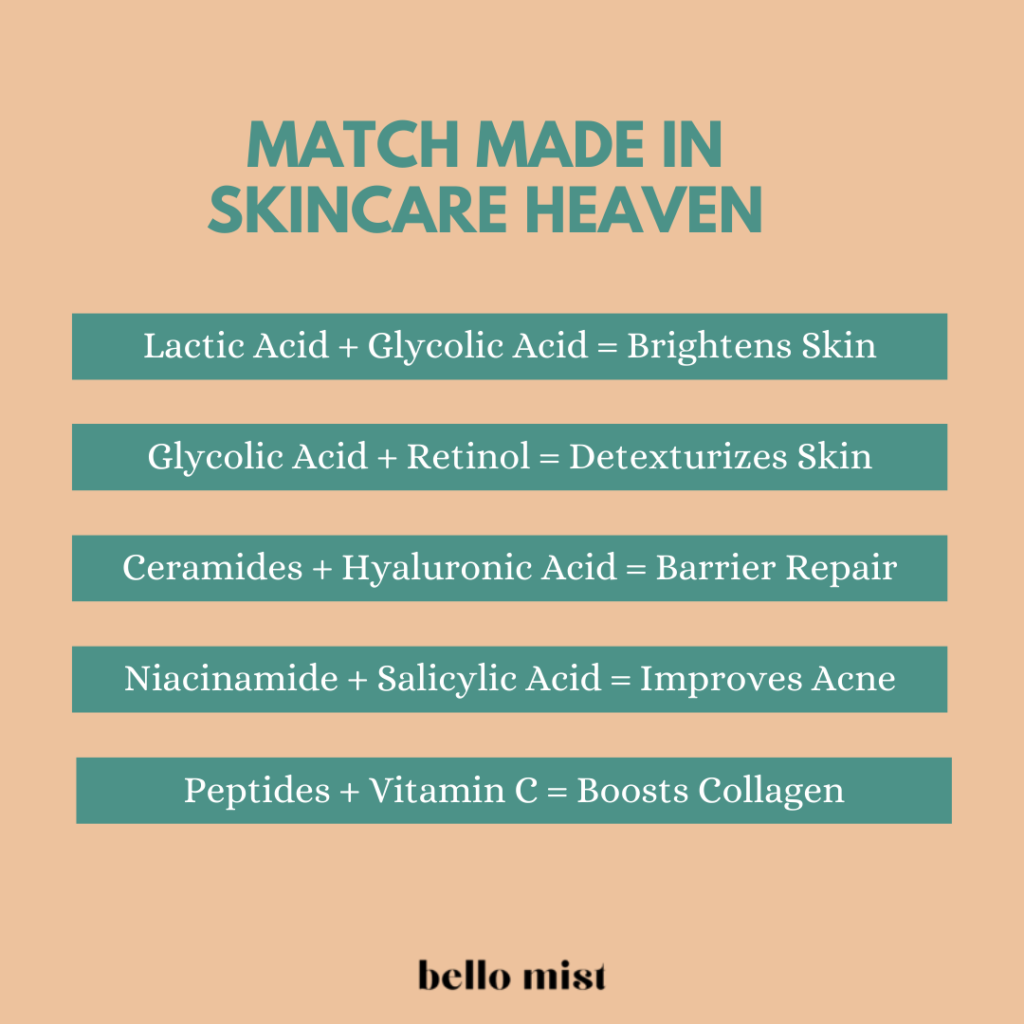
Wrapping Up
Salicylic acid and niacinamide are both proven powerhouses in the skincare world.
Salicylic acid is a classic choice for eliminating too much oil and sebum. Niacinamide is a multi-talented ingredient that can shrink pores, decrease inflammation, help skin restore its protective barrier, and regulate oil production.
These two ingredients are even better when they team up, as salicylic acid is oil-soluble and can reach into the deeper layers of the skin. It can also cause dehydration and irritation.
On the other hand, Niacinamide can reduce inflammation and boost the skin’s natural hydration. Together, salicylic acid and niacinamide create a dynamic duo that can get the job done.
Read More
Can you use BHA with Retinol? In-depth analysis, effects, and comparison 2023
11 Best Korean Vitamin C serums to give your skin a boost
